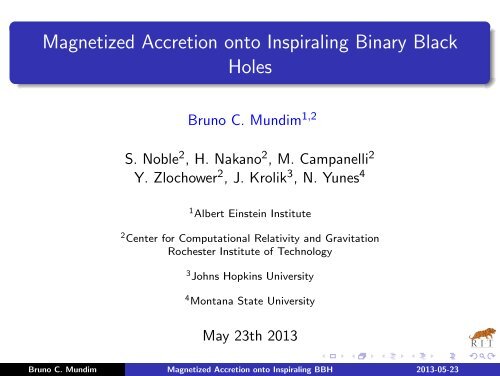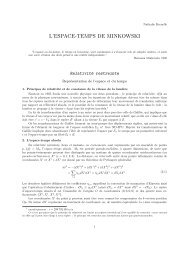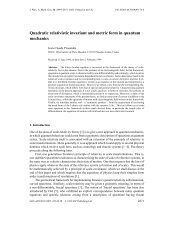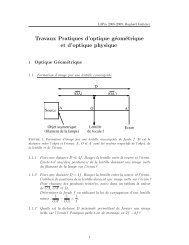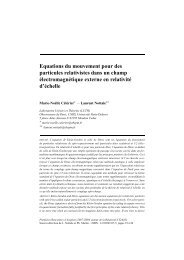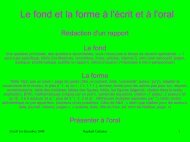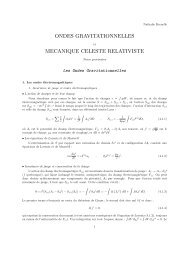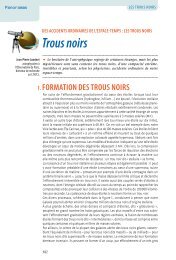Magnetized Accretion onto Inspiraling Binary Black Holes - LUTH
Magnetized Accretion onto Inspiraling Binary Black Holes - LUTH
Magnetized Accretion onto Inspiraling Binary Black Holes - LUTH
Create successful ePaper yourself
Turn your PDF publications into a flip-book with our unique Google optimized e-Paper software.
<strong>Magnetized</strong> <strong>Accretion</strong> <strong>onto</strong> <strong>Inspiraling</strong> <strong>Binary</strong> <strong>Black</strong><br />
<strong>Holes</strong><br />
Bruno C. Mundim 1,2<br />
S. Noble 2 , H. Nakano 2 , M. Campanelli 2<br />
Y. Zlochower 2 , J. Krolik 3 , N. Yunes 4<br />
1 Albert Einstein Institute<br />
2 Center for Computational Relativity and Gravitation<br />
Rochester Institute of Technology<br />
3 Johns Hopkins University<br />
4 Montana State University<br />
May 23th 2013<br />
Bruno C. Mundim <strong>Magnetized</strong> <strong>Accretion</strong> <strong>onto</strong> <strong>Inspiraling</strong> BBH 2013-05-23
Astrophysical Motivation<br />
Massive <strong>Binary</strong> <strong>Black</strong>-Hole Mergers:<br />
MBHs are observed at the centers of all galaxies with bulges<br />
(Gueltekin++2009,etc).<br />
Hiererchical build-up of galaxies from smaller structures<br />
(Springel++2005): galaxy merger leads to BBH merger.<br />
Torques from gas, stellar dynamical friction, gravitational slingshot<br />
bring the pair to sub-pc scales.<br />
GW emission drive the binary to the final merger.<br />
Merger/Post-Merger could also be observable in EM spectrum,<br />
provided enough gas is present.<br />
Potential for GW-EM astronomy:<br />
Standard sirens: new distance vs. readshift measurement<br />
Mutual beneficial localization: LISA localization days in advance.<br />
EM localization using high-cadence, all-sky observations.<br />
Understanding of BH dynamics, merger scenarios, highly relativistic<br />
plasma, jet formation, etc.<br />
Need dynamical models to predict source variability accurately and<br />
distinguish them from single AGNs.<br />
Bruno C. Mundim <strong>Magnetized</strong> <strong>Accretion</strong> <strong>onto</strong> <strong>Inspiraling</strong> BBH 2013-05-23
Astrophysical Motivation<br />
Do systematic studies of each stage of the coalescence, bridging gaps<br />
among stages.<br />
Circumbinary Disk Dynamics & Gravity Modeling:<br />
Newtonian regime (a 100M):<br />
tmerger = a/˙a >> tinflow = M(< r)/ ˙M<br />
Post-newtonian regime (10M a 100M):<br />
Strong field regime (a 10M):<br />
tmerger tinflow<br />
tmerger < tinflow<br />
Bruno C. Mundim <strong>Magnetized</strong> <strong>Accretion</strong> <strong>onto</strong> <strong>Inspiraling</strong> BBH 2013-05-23
BBH Metric Analytic Approximation: Initial Data<br />
Global, analytic approximation for the metric describing the late<br />
quasi-circular inspiral of two comparable black-holes (Yunes et al.<br />
(2006a, 2006b); Johnson-McDaniel et al. (2009)).<br />
Inner Zone (ri > mi and r ≤ λ/2π): (slow-motion/weak field:<br />
ɛi = mi/ri ∼ (vi/c) 2 ) post-Newtonian theory of point-particles in<br />
harmonic coordinates (Blanchet-Faye-Ponsot (1998)). Gravitational<br />
radiation contents are treated perturbatively.<br />
Far Zone (r ≥ λ/2π): post-Minkowskian theory. Harmonic<br />
coordinates. Expansion in terms of radiative multipole moments.<br />
Non-perturbative gravitational radiation treatment.<br />
Bruno C. Mundim <strong>Magnetized</strong> <strong>Accretion</strong> <strong>onto</strong> <strong>Inspiraling</strong> BBH 2013-05-23
BBH Metric Analytic Approximation: Initial Data<br />
Buffer Zone (O )<br />
34<br />
00000000000000000000000000000000000000000000000000<br />
11111111111111111111111111111111111111111111111111<br />
11111111111111111111111111111111111111111111111111<br />
00000000000000000000000000000000000000000000000000<br />
00000000000000000000000000000000000000000000000000<br />
11111111111111111111111111111111111111111111111111<br />
11111111111111111111111111111111111111111111111111<br />
00000000000000000000000000000000000000000000000000<br />
00000000000000000000000000000000000000000000000000<br />
11111111111111111111111111111111111111111111111111<br />
11111111111111111111111111111111111111111111111111<br />
3<br />
00000000000000000000000000000000000000000000000000<br />
Inner Zone BH 2 (C )<br />
00000000000000000000000000000000000000000000000000<br />
11111111111111111111111111111111111111111111111111<br />
11111111111111111111111111111111111111111111111111<br />
00000000000000000000000000000000000000000000000000<br />
00000000000000000000000000000000000000000000000000<br />
11111111111111111111111111111111111111111111111111<br />
000000000<br />
00000000000000000000000000000000000000000000000000<br />
111111111 2<br />
11111111111111111111111111111111111111111111111111<br />
111111111<br />
13<br />
000000<br />
111111<br />
000000000<br />
11111111111111111111111111111111111111111111111111<br />
00000000000000000000000000000000000000000000000000<br />
00000000000000000000000000000000000000000000000000<br />
000000000<br />
111111111<br />
000000<br />
11111111111111111111111111111111111111111111111111<br />
111111<br />
111111111<br />
000000<br />
111111<br />
000000000<br />
11111111111111111111111111111111111111111111111111<br />
00000000000000000000000000000000000000000000000000<br />
00000000000000000000000000000000000000000000000000<br />
000000000<br />
111111111<br />
000000<br />
11111111111111111111111111111111111111111111111111<br />
111111<br />
111111111<br />
000000<br />
111111<br />
000000000<br />
11111111111111111111111111111111111111111111111111<br />
00000000000000000000000000000000000000000000000000<br />
Buffer<br />
Zone<br />
(O )<br />
y<br />
Buffer<br />
Zone (O )<br />
Far Zone (C )<br />
4<br />
Inner Zone BH 1 (C )<br />
BH 1<br />
00000000000000000000000000000000000000000000000000<br />
000000000<br />
111111111<br />
000000<br />
11111111111111111111111111111111111111111111111111<br />
111111<br />
111111111<br />
000000000<br />
11111111111111111111111111111111111111111111111111<br />
00000000000000000000000000000000000000000000000000<br />
00000000000000000000000000000000000000000000000000<br />
000000000<br />
11111111111111111111111111111111111111111111111111<br />
111111111<br />
1<br />
11111111111111111111111111111111111111111111111111<br />
00000000000000000000000000000000000000000000000000<br />
BH 2<br />
Near Zone (C )<br />
00000000000000000000000000000000000000000000000000<br />
11111111111111111111111111111111111111111111111111<br />
11111111111111111111111111111111111111111111111111<br />
00000000000000000000000000000000000000000000000000<br />
00000000000000000000000000000000000000000000000000<br />
11111111111111111111111111111111111111111111111111<br />
11111111111111111111111111111111111111111111111111<br />
23<br />
00000000000000000000000000000000000000000000000000<br />
00000000000000000000000000000000000000000000000000<br />
11111111111111111111111111111111111111111111111111<br />
11111111111111111111111111111111111111111111111111<br />
00000000000000000000000000000000000000000000000000<br />
00000000000000000000000000000000000000000000000000<br />
11111111111111111111111111111111111111111111111111<br />
11111111111111111111111111111111111111111111111111<br />
00000000000000000000000000000000000000000000000000<br />
11111111111111111111111111111111111111111111111111<br />
00000000000000000000000000000000000000000000000000<br />
Bruno C. Mundim <strong>Magnetized</strong> <strong>Accretion</strong> <strong>onto</strong> <strong>Inspiraling</strong> BBH 2013-05-23<br />
b<br />
x
BBH Metric Analytic Approximation: Zones<br />
Zone rin rout<br />
Inner zone 1 (r1) 0 ≪ r12<br />
Inner zone 2 (r2) 0 ≪ r12<br />
Near zone (rA) ≫ mA ≪ λ<br />
Far zone (r) ≫ r12 ∞<br />
r12: Orbital separation<br />
λ: GW wavelength<br />
Zone Region<br />
IZ-NZ buffer zone mA ≪ rA ≪ r12<br />
NZ-FZ buffer zone r12 ≪ r ≪ λ<br />
BZ(NZ-FZ)<br />
IZ2<br />
y<br />
NZ<br />
BZ(IZ2-NZ)<br />
r12<br />
IZ1<br />
BZ(IZ1-NZ)<br />
Bruno C. Mundim <strong>Magnetized</strong> <strong>Accretion</strong> <strong>onto</strong> <strong>Inspiraling</strong> BBH 2013-05-23<br />
FZ<br />
x
BBH Metric Analytic Approximation: Inner Zone<br />
Inner Zone (IZ)<br />
(Non-spinning) BH + tidal<br />
perturbations<br />
gµν = g CS<br />
µν + hµν ,<br />
Horizon penetrating<br />
coordinates:<br />
Cook and Scheel’s<br />
harmonic coordinates<br />
Parametrization:<br />
hµν = qµν(x i )Eµν(t) + kµν(x i )Bµν(t) ,<br />
Tidal fields: Eµν and Bµν are<br />
elect. and mag. multipoles of<br />
the external universe’s Weyl<br />
BZ(NZ-FZ)<br />
IZ2<br />
y<br />
NZ<br />
BZ(IZ2-NZ)<br />
r12<br />
IZ1<br />
BZ(IZ1-NZ)<br />
Bruno C. Mundim <strong>Magnetized</strong> <strong>Accretion</strong> <strong>onto</strong> <strong>Inspiraling</strong> BBH 2013-05-23<br />
FZ<br />
x
BBH Metric Analytic Approximation: Near Zone<br />
Near Zone (NZ)<br />
Flat + non-linear perturbation<br />
gµν = ηµν + hµν ,<br />
post-Newtonian approach<br />
(slow motion, weak field)<br />
ηhµν ∝ Tµν(y i A) + τµν(h 2 ) ,<br />
Harmonic coordinates<br />
Parametrization:<br />
htt = 2m1<br />
2 m1 + O ,<br />
r1<br />
m1<br />
v<br />
r1<br />
2 , v 4<br />
<br />
,<br />
r 2 1<br />
BZ(NZ-FZ)<br />
IZ2<br />
y<br />
NZ<br />
BZ(IZ2-NZ)<br />
r12<br />
IZ1<br />
BZ(IZ1-NZ)<br />
Bruno C. Mundim <strong>Magnetized</strong> <strong>Accretion</strong> <strong>onto</strong> <strong>Inspiraling</strong> BBH 2013-05-23<br />
FZ<br />
x
BBH Metric Analytic Approximation: Far Zone<br />
Far Zone (FZ)<br />
Flat + multipoles<br />
gµν = ηµν + hµν ,<br />
post-Minkowskian theory<br />
(slow motion, weak field)<br />
Harmonic coordinates<br />
Time retardation u = t − r<br />
based on the flat-spacetime<br />
retarded Green function<br />
Parametrization:<br />
h tt <br />
1<br />
∝ ∂L<br />
r IL(u)<br />
<br />
,<br />
BZ(NZ-FZ)<br />
IZ2<br />
y<br />
NZ<br />
BZ(IZ2-NZ)<br />
r12<br />
IZ1<br />
BZ(IZ1-NZ)<br />
Bruno C. Mundim <strong>Magnetized</strong> <strong>Accretion</strong> <strong>onto</strong> <strong>Inspiraling</strong> BBH 2013-05-23<br />
FZ<br />
x
BBH Metric Analytic Approximation: Buffer Zones<br />
Buffer Zone (BZ)<br />
Asymptotic matching and<br />
transition functions<br />
NZ-FZ (Same Coords.)<br />
Only transition functions.<br />
IZ-NZ (Different Coords.)<br />
Tidal fields and Coord. Trans.<br />
set in the matching<br />
BZ(NZ-FZ)<br />
IZ2<br />
y<br />
NZ<br />
BZ(IZ2-NZ)<br />
r12<br />
IZ1<br />
BZ(IZ1-NZ)<br />
Bruno C. Mundim <strong>Magnetized</strong> <strong>Accretion</strong> <strong>onto</strong> <strong>Inspiraling</strong> BBH 2013-05-23<br />
FZ<br />
x
BBH Metric Analytic Approximation: Evolution<br />
Asymptotic matching fixes the coordinate transformation<br />
(perturbatively) and the tidal fields in the IZ.<br />
Problem: it assumes both BHs lie on x-axis at t = t0 for some inertial<br />
coordinate system.<br />
How to adapt this metric for evolution?<br />
Solution: rigid rotation of the spatial coordinates back and forth.<br />
The location of each hole in the NZ coordinates:<br />
x k i,NZ = {ri cos φ, ri sin φ, 0}<br />
Transform NZ and FZ metrics to a coordinates where the holes lie on<br />
the x-axis, match them to the IZ, and transform the full metric<br />
(IZ+NZ+FZ) back to the simulation inertial coordinates:<br />
x ′ NZ = xNZ cos φ + yNZ sin φ<br />
y ′ NZ = −xNZ sin φ + yNZ cos φ<br />
Bruno C. Mundim <strong>Magnetized</strong> <strong>Accretion</strong> <strong>onto</strong> <strong>Inspiraling</strong> BBH 2013-05-23
Error Analysis: Ricci Tensor and Ricci Scalar<br />
Christoffel symbols and derivatives:<br />
Γ ρ µν = 1<br />
2 g ρσ [gνσ,µ + gµσ,ν − gµν,σ]<br />
Ricci Tensor:<br />
Γ ρ<br />
µν,λ<br />
= 1<br />
2 g ρσ ,λ [gνσ,µ + gµσ,ν − gµν,σ]<br />
+ 1<br />
2 g ρσ [gνσ,µλ + gµσ,νλ − gµν,σλ]<br />
Rµρ = Γ ν µρ,ν − Γ ν νρ,µ + Γ α µρΓ ν αν − Γ α νρΓ ν αµ<br />
Ricci Scalar: R = R µ µ.<br />
In vacuum, an exact metric solution satisfies:<br />
Rµν = 0 and R = 0<br />
While our aproximate analytic metric has an error associated with it:<br />
Rµν = O(ɛ) and R = O(ɛ)<br />
Bruno C. Mundim <strong>Magnetized</strong> <strong>Accretion</strong> <strong>onto</strong> <strong>Inspiraling</strong> BBH 2013-05-23
Ricci Scalar 2nd Order Convergence<br />
Figure: (Left) L2-norm calculated over a simulation domain ranging from<br />
[−12, −12, −0.75] to [12, 12, 0.75] with a uniform mesh spacing following a 2 : 1<br />
ratio. (Right) Ricci l2-norm over the same volume for the coarsest mesh spacing,<br />
0.05M. Vertical dashed lines from left to right indicate separations of 14M, 12M,<br />
10M and 8M.<br />
Bruno C. Mundim <strong>Magnetized</strong> <strong>Accretion</strong> <strong>onto</strong> <strong>Inspiraling</strong> BBH 2013-05-23
Ricci Scalar 2nd Order Convergence<br />
Bruno C. Mundim <strong>Magnetized</strong> <strong>Accretion</strong> <strong>onto</strong> <strong>Inspiraling</strong> BBH 2013-05-23
Ricci Scalar 2nd Order Convergence<br />
Bruno C. Mundim <strong>Magnetized</strong> <strong>Accretion</strong> <strong>onto</strong> <strong>Inspiraling</strong> BBH 2013-05-23
Ricci Scalar: Evolution<br />
Bruno C. Mundim <strong>Magnetized</strong> <strong>Accretion</strong> <strong>onto</strong> <strong>Inspiraling</strong> BBH 2013-05-23
Ricci Scalar: Evolution<br />
Figure: Ricci scalar as a function of time from a separation of 20M to 8M on left<br />
panel (linear color scale). Absolute value of the Ricci scalar on the right panel<br />
(log color scale). Approximately 10 grid points across the horizon radius<br />
(rBH = 0.4875M).<br />
Bruno C. Mundim <strong>Magnetized</strong> <strong>Accretion</strong> <strong>onto</strong> <strong>Inspiraling</strong> BBH 2013-05-23
Ricci Scalar as a Function of Approximation Order<br />
Bruno C. Mundim <strong>Magnetized</strong> <strong>Accretion</strong> <strong>onto</strong> <strong>Inspiraling</strong> BBH 2013-05-23
Ricci Scalar as a Function of Approximation Order<br />
Bruno C. Mundim <strong>Magnetized</strong> <strong>Accretion</strong> <strong>onto</strong> <strong>Inspiraling</strong> BBH 2013-05-23
Circumbinary Disks<br />
Newtonian Hydrodynamic Simulations:<br />
BBH exerts torque on gas via its time-varying mass quadrupole<br />
moment.<br />
BBH torque restores some of the accreting gas’ angular momentum,<br />
thereby diminishing the mass accretion rate through the gas.<br />
Surface density tends to build-up at r ∼ 2a as matter accretes faster<br />
beyond gap.<br />
Newtonian MHD Simulations:<br />
MHD torques seem to be able to accrete more material through the<br />
gap, but gap still exists.<br />
GRMHD Simulations in the post-Newtonian Regime (our project):<br />
Can MHD torques keep the disk/gap near the binary?<br />
What is the mass distribution in the inner disk? It is crucial for<br />
accurate EM models as emissivity typically scales as ρ n<br />
Bruno C. Mundim <strong>Magnetized</strong> <strong>Accretion</strong> <strong>onto</strong> <strong>Inspiraling</strong> BBH 2013-05-23
Circumbinary <strong>Magnetized</strong> Disks: Simulation Setup<br />
Two simulations with initial binary separation of a0 = 20M:<br />
Secularly evolving run, RunSE: binary evolves at an artificially fixed<br />
separation for ∼ 75000M (or ∼ 140 orbits).<br />
Inspiral run, RunIn, binary starts at a RunSE snapshot, t = 40000M<br />
(or ∼ 100 orbits), to let the disk relax. It inspirals afterwards up to<br />
a 8M.<br />
2.5PN (NZ) metric; Domain: r = [0.75a0, 13a0] = [15M, 260M]<br />
<strong>Binary</strong> separation, a(t), and orbital phase, φ(t), up to 3.5PN.<br />
Bruno C. Mundim <strong>Magnetized</strong> <strong>Accretion</strong> <strong>onto</strong> <strong>Inspiraling</strong> BBH 2013-05-23
Circumbinary <strong>Magnetized</strong> Disks: Disk Initial Data<br />
Radiatively efficient, geometrically thin accretion disk:<br />
Disk extended over r = [3a0, 10a0].<br />
Pressure maximum at rp = 5a0.<br />
Poloidal magnetic field following density c<strong>onto</strong>urs.<br />
Near “equilibrim” disk solution using time averaged spacetime.<br />
Cool to constant entropy such that the disk aspect ratio is constant<br />
and H/r = 0.1<br />
Cooling function can be used as an emissivity in a GR ray-tracing code.<br />
Bruno C. Mundim <strong>Magnetized</strong> <strong>Accretion</strong> <strong>onto</strong> <strong>Inspiraling</strong> BBH 2013-05-23
Surface Density: Evolution<br />
Figure: Surface density time evolution (log 10 color scale) for RunIN (left) and<br />
RunSE (right).<br />
<br />
Σ(r, φ) ≡<br />
dθ √ <br />
−gρ/ gφφ(θ = π/2); (1)<br />
Bruno C. Mundim <strong>Magnetized</strong> <strong>Accretion</strong> <strong>onto</strong> <strong>Inspiraling</strong> BBH 2013-05-23
Surface Density: Streams and Lump<br />
Figure: Color c<strong>onto</strong>urs of surface density in log 10 (left) and linear (right) color<br />
scales, emphasizing the streams from the disk toward the binary members and the<br />
asymmetric density growth in the inner disk, respectively.<br />
Bruno C. Mundim <strong>Magnetized</strong> <strong>Accretion</strong> <strong>onto</strong> <strong>Inspiraling</strong> BBH 2013-05-23
Surface Density: Azimuthally Averaged<br />
Figure: Color c<strong>onto</strong>urs of log 10 Σ(r) as a function of time for RunIN (left) and<br />
RunSE (right). The black dashed curve shows 2a(t).<br />
Bruno C. Mundim <strong>Magnetized</strong> <strong>Accretion</strong> <strong>onto</strong> <strong>Inspiraling</strong> BBH 2013-05-23
Surface Density: Azimuthally Averaged<br />
Figure: Color c<strong>onto</strong>urs of log 10 Σ(r/a(t)) as a function of time for RunIN (left)<br />
and RunSE (right).<br />
Bruno C. Mundim <strong>Magnetized</strong> <strong>Accretion</strong> <strong>onto</strong> <strong>Inspiraling</strong> BBH 2013-05-23
Surface Density: Azimuthally Averaged<br />
Bruno C. Mundim <strong>Magnetized</strong> <strong>Accretion</strong> <strong>onto</strong> <strong>Inspiraling</strong> BBH 2013-05-23
<strong>Accretion</strong> Rate<br />
Figure: (Left) <strong>Accretion</strong> rate through the inner boundary: RunSE (black) and<br />
RunIN (gray). (Right) Time-averaged accretion rate during four equally spaced<br />
segments from t = 30, 000M (black) till the end of RunSE.<br />
Both RunIN and RunSE accretion rate decrease over time.<br />
Decrease due largely to torques. Decrease of RunIN also due to<br />
binary orbital decoupling.<br />
Bruno C. Mundim <strong>Magnetized</strong> <strong>Accretion</strong> <strong>onto</strong> <strong>Inspiraling</strong> BBH 2013-05-23
Luminosity Variability<br />
Figure: (r, t) spacetime (left) and luminosity integrated over radius (right).<br />
Bruno C. Mundim <strong>Magnetized</strong> <strong>Accretion</strong> <strong>onto</strong> <strong>Inspiraling</strong> BBH 2013-05-23
Luminosity Variability<br />
Figure: (r, t) spacetime (left) and luminosity integrated over radius (right).<br />
Bruno C. Mundim <strong>Magnetized</strong> <strong>Accretion</strong> <strong>onto</strong> <strong>Inspiraling</strong> BBH 2013-05-23
Luminosity Variability<br />
Figure: (r, t) spacetime (left) and luminosity integrated over radius (right).<br />
Bruno C. Mundim <strong>Magnetized</strong> <strong>Accretion</strong> <strong>onto</strong> <strong>Inspiraling</strong> BBH 2013-05-23
Luminosity Variability<br />
Figure: (r, ω) spacetime (left) and FPS of luminosity integrated over radius<br />
(right).<br />
Bruno C. Mundim <strong>Magnetized</strong> <strong>Accretion</strong> <strong>onto</strong> <strong>Inspiraling</strong> BBH 2013-05-23
Luminosity Variability<br />
Figure: (r, ω) spacetime (left) and FPS of luminosity integrated over radius<br />
(right).<br />
Bruno C. Mundim <strong>Magnetized</strong> <strong>Accretion</strong> <strong>onto</strong> <strong>Inspiraling</strong> BBH 2013-05-23
Luminosity Variability: Discussion<br />
Fourier power spectrum shows a strong, sharp peak at frequency<br />
ωpeak = 1.47Ωbin with rpeak 2.3a.<br />
and a weaker peak at the Ωlump = 0.26Ωbin, corresponding to the<br />
orbital frequency at the radius of the surface density maximum<br />
rlump 2.4a.<br />
We can identify ωpeak with the rate at which the lump approaches the<br />
orbital phase of a member of the binary: ωpeak = 2(Ωbin − Ωlump).<br />
When the lump draws close to one of the BHs, a new stream forms,<br />
falls inward, and it is split into two pieces. One of them gains angular<br />
momentum and sweeps back out to the disk, and shocks against the<br />
gas.<br />
It is this process that modulates the light curve.<br />
Bruno C. Mundim <strong>Magnetized</strong> <strong>Accretion</strong> <strong>onto</strong> <strong>Inspiraling</strong> BBH 2013-05-23
Conclusion and Future Work<br />
Demonstrated consistency with prior work in the Newtonian regime.<br />
Investigated the evolution of the disk with separation.<br />
A disk can follow the binary to very small separations, before<br />
decoupling.<br />
Measured the luminosity from a self-consistent cooling rate.<br />
Luminosity characteristic of AGN with excess at edge of gap due to<br />
dissipated binary torque work.<br />
Strong periodic signal found from the binary-lump interaction<br />
We need ray-trace in order to conclude if disk opacity will blur the<br />
signal.<br />
Need to calculate the dynamics in the vicinity of black holes<br />
How does the lump evolve after merger?<br />
Does the lump form with unequal mass or precessing binaries?<br />
Bruno C. Mundim <strong>Magnetized</strong> <strong>Accretion</strong> <strong>onto</strong> <strong>Inspiraling</strong> BBH 2013-05-23
Extra Slides<br />
Bruno C. Mundim <strong>Magnetized</strong> <strong>Accretion</strong> <strong>onto</strong> <strong>Inspiraling</strong> BBH 2013-05-23
Ricci Scalar: Evolution (Zoom Around a <strong>Black</strong>-Hole)<br />
Bruno C. Mundim <strong>Magnetized</strong> <strong>Accretion</strong> <strong>onto</strong> <strong>Inspiraling</strong> BBH 2013-05-23
Ricci Scalar: Evolution (Zoom Around a <strong>Black</strong>-Hole)<br />
Figure: Ricci scalar absolute value on a linear color scale around the “right” BH<br />
at t = 660M. The mesh spacing is 0.0125M (left) and 0.00625M (right)<br />
resulting into 39 and 78 grid points per horizon radius (rBH = 0.4875M).<br />
Bruno C. Mundim <strong>Magnetized</strong> <strong>Accretion</strong> <strong>onto</strong> <strong>Inspiraling</strong> BBH 2013-05-23
Ricci Scalar: Case for Higher Order Approximations.<br />
2nd order FDAs result in large computational effort to calculate the<br />
Ricci scalar to perturbative order accuracy, Rµν = O(ɛ).<br />
4th order approximation leads to faster convergence.<br />
For example, pick a point at the horizon, (0.0, 9.673556531, 0.3, 0.2),<br />
for an initial separation of 20M. The various quantities on the table 2<br />
below start to agree on the first significant figure only when<br />
dt = dx = dy = dz = h = 0.00625M, or 78 grid points per rBH.<br />
Note that a typical equal mass BHB simulation using full GR uses<br />
approximately 20 grid points per rAH on the finest AMR grid.<br />
Bruno C. Mundim <strong>Magnetized</strong> <strong>Accretion</strong> <strong>onto</strong> <strong>Inspiraling</strong> BBH 2013-05-23
Ricci Scalar: Case for Higher Order Approximations.<br />
2nd: 4th:<br />
Rtt = 0.01024587050684905 Rtt = 0.01007850127240062<br />
Rtx = 0.03228380078907006 Rtx = 0.0340889478274195<br />
Rty = −0.02308902839605859 Rty = −0.02298639795941293<br />
Rtz = −0.02006201110556877 Rtz = −0.02032786334618492<br />
Rxx = −0.6774182693609987 Rxx = −0.6650699268486431<br />
Rxy = 0.3413360547161979 Rxy = 0.3261324979719031<br />
Rxz = 0.348427534006535 Rxz = 0.3356062612167152<br />
Ryy = −0.1977530448946112 Ryy = −0.2060409626394311<br />
Ryz = −0.1865524325067573 Ryz = −0.1884958238515893<br />
Rzz = −0.2906179378901275 Rzz = −0.297516599915685<br />
R = −0.2657411795293186 R = −0.2698938651121096<br />
H = 0.01469997464077989 H = 0.0131591785513933<br />
M = 0.01504264551925634 M = 0.0167759321900986<br />
Table: Ricci tensor, scalar and constraints calculated using 2nd (left) and 4th<br />
(right) order FDA operators.<br />
Bruno C. Mundim <strong>Magnetized</strong> <strong>Accretion</strong> <strong>onto</strong> <strong>Inspiraling</strong> BBH 2013-05-23
Ricci Scalar: Case for Higher Order Approximations.<br />
h=0.0125: h=0.025: h=0.05:<br />
Rtt = 0.003196804677 0.01525931246 −0.7872097038<br />
Rtx = 0.06012934193 1.021136533 18.02810729<br />
Rty = −0.07799147144 −1.345320048 −22.01926661<br />
Rtz = 0.002133967513 0.01126266918 0.08158737450<br />
Rxx = 0.04656790023 0.7555766992 11.79503573<br />
Rxy = −0.006635370634 −0.1286574330 −1.910954363<br />
Rxz = 0.05114508275 0.8262931061 12.41963629<br />
Ryy = 0.3721293525 6.343315783 104.1051001<br />
Ryz = 0.07746675602 1.328459405 23.84528796<br />
Rzz = 0.05812650456 0.9723960616 16.50214637<br />
R = 0.08089705926 1.351036267 21.89512132<br />
H = −0.7001806355 −11.94584103 −195.1180949<br />
M = 0.1307027219 2.205683272 26.61166151<br />
Table: Percentile variation with respect to reference resolution, h = 0.00625M for<br />
4th order FDA. 39 (left), 20 (center) and 10 (right) grid points per rBH.<br />
Bruno C. Mundim <strong>Magnetized</strong> <strong>Accretion</strong> <strong>onto</strong> <strong>Inspiraling</strong> BBH 2013-05-23
Transition Function Effects<br />
Transition function used in the buffer zones:<br />
⎧<br />
⎪⎨ 0 , r ≤ r0 ,<br />
f = 1<br />
⎪⎩<br />
2 (1 + tanh{(s/π)[χ − q2 /χ]}) ,<br />
1 ,<br />
r0 < r < r0 + w ,<br />
r ≥ r0 + w ,<br />
where χ = χ(r, r0, w) = tan[π(r − r0)/(2w)] and<br />
f = f (r, r0, w, q, s).<br />
Focus on the NZ-FZ buffer zone, since this region results into a large<br />
“bump” when higher order PN terms are used.<br />
Bruno C. Mundim <strong>Magnetized</strong> <strong>Accretion</strong> <strong>onto</strong> <strong>Inspiraling</strong> BBH 2013-05-23<br />
(2)
Transition Function Effects<br />
Figure: Transition function for different values of parameters q and s as in<br />
f (r, r0, w, q, s).<br />
Bruno C. Mundim <strong>Magnetized</strong> <strong>Accretion</strong> <strong>onto</strong> <strong>Inspiraling</strong> BBH 2013-05-23
Transition Function Effects<br />
Figure: (Left) Comparison of the resummed O(v 5 ) Ricci Scalar between the NZ<br />
and FZ metrics. (Right) Resummed O(v 5 ) Ricci Scalar for different values of<br />
transition function parameters q and s as in f (r, r0, w, q, s).<br />
Bruno C. Mundim <strong>Magnetized</strong> <strong>Accretion</strong> <strong>onto</strong> <strong>Inspiraling</strong> BBH 2013-05-23
Transition Function Effects<br />
Figure: Resummed O(v 5 ) gxy IZ, NZ and FZ pieces (left) and gxy (right) for<br />
different values of transition function parameters q and s as in f (r, r0, w, q, s).<br />
Bruno C. Mundim <strong>Magnetized</strong> <strong>Accretion</strong> <strong>onto</strong> <strong>Inspiraling</strong> BBH 2013-05-23


